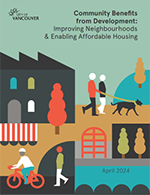To help deliver the facilities and infrastructure needed to serve a growing Vancouver, we look to ensure that new development contributes to neighbourhoods where change occurs.
Development contributions come in the form of Community Amenity Contributions (CACs), Development Cost Levies (DCLs), and density bonus zoning.
What's happening2026 financing growth update
We are currently working on a comprehensive update to our development contribution tools.
DCL and CAC deferrals and 2025 inflationary adjustment
On June 18, 2025, Council approved a package of development viability initiatives to help unlock new housing supply. These changes take effect immediately and include:
- Allowing projects with total DCLs over $500,000 to pay the DCLs over 3 equal instalments
- Lowering the threshold for cash CAC deferrals
- Increasing the use of surety bonds
- Foregoing the 2025 inflationary adjustment of 3.2% to DCLs, CAC Targets, and density bonus contributions, as well as rolling back the 2024 inflationary adjustment of 5.7% to CAC Targets and density bonus contributions
For details, review the Development Viability Initiatives Council report PDF file (312 KB) and the 2025 DCL bulletin PDF file (848 KB).
Metro Vancouver DCC update
Metro Vancouver Board approved increases to the Metro Vancouver Liquid Waste DCC and Water DCC, along with introducing a Parkland acquisition DCC.
Learn more about the changes in Metro Vancouver External website, opens in new tab
Types of development contributions
The community benefits above are delivered with help from these types of development contributions.
Guiding principles on development contributions
We manage the increased demands for facilities by following these principles:
- Community liveability should be maintained as the city grows.
- New developments should contribute to the cost of growth and their impact on the community.
- The cost of City facilities and services should be shared between new and existing developments.
- The economic impact of our development contributions should not affect development or housing affordability.
- Our system should be consistent, transparent, simple, and flexible.
Contact us
Email: [email protected]

